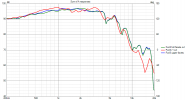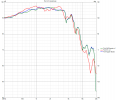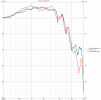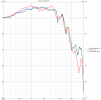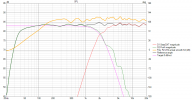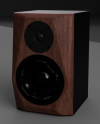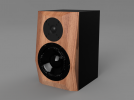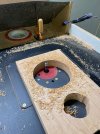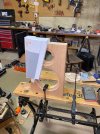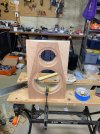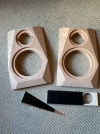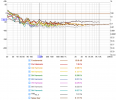As I make some decisions about enclosure construction, I thought I'd share a few measurements that I took to guide me. Thanks to @tktran for learnings he's shared, as well as to
@augerpro for things he's shared on his website.
The prototype box is generic big box store 7-ply 3/4" nominal (18 mm actual) plywood, doubled for the baffle. The Purifi has the stock gasket that comes with it and is secured directly with screws into the wood. The DXT and PR are also secured by screws directly into the wood, the DXT with thin closed cell foam gasket tape (from PE), and the PR with its stock gasket. Outside dimensions of the enclosure (without the baffle) are 8.4 x 13.6" sides and 8.5 x 8.4" top and bottom. There is no cross bracing. The top and side walls are covered by a single piece of 1" thick denim insulation that wraps fully around the interior.
Questions on my mind are
- Do I need cross bracing? Put a better way, would cross bracing make an audible difference? A material audible difference?
- Is there good reason to isolate the driver, i.e., to decouple the driver frame from the baffle?
- Is there good reason to support the driver magnet?
Driver mounting
Taking #2 first... In
this post, Lars Risbo from Purifi briefly reports on experiments done at the company. In brief, "The conclusion: just tighten the screws well and worry only about all the so many other important aspects of speaker box design." He notes that tightening the mounting screws well is important to prevent buzzing, i.e., movements between solid parts. He notes as well that supporting the magnet with a dissipative material between it and the supporting structure is helpful.
In post #64 above, I show a distortion plot where, at 447 Hz, THD is only 24 dB down from the main response. I can report that tightening the mounting screws and placing a foam pad between the speaker and the hard plastic table I was using made that peak vanish. Together with what I'll share below, this supports Lars' statement about the sufficiency of solid mounting.
That's not to say that going beyond conventional "solid" mounting won't be useful. One simple approach involves a relatively thick gasket between frame and baffle, together with a compliant washer (or O-ring) between the screw head and the frame. The "hard" mount is likely to be susceptible to loosening as the gasket material conforms over time, with thermal cycles, etc. A softer mount, whether or not the isolation makes an audible difference in this case, may be more tolerant of those changes. This is, of course, speculation.
Enclosure bracing and/or damping
The closer we are to what can be expected of the drivers, or at least to what is audible, the less need to investigate means of mitigation.
Below is the result of an
un-gated in-room sweep at 1 m, for the entire signal chain, from source (TASCAM US-1x2 HR over USB) through development crossover (generic AD17xxxx 24-bit dsp), through the amp (Extron XPA-1002 PLUS), to the mounted drivers.
Here's the same data displayed as relative dB. if our goal is for THD to be at least 40 dB down (< 1%), we're already there down to 200 Hz, and down to about 60 Hz the peaks in THD
relative to signal occur substantially due to dips in the signal.
It's helpful to look at near field response. The plot below was taken at 15 mm from the Purifi cone.
As relative dB,
As helpful as I find it to look at dBr plots (saves having to mentally subtract), it's important to remember that the peak in the mid-30's correponds to the dip in the Purifi response that gets filled in by the PR in the full system response.
In
Erin's testing of the driver (yes - it's the W version), his nearfield (0.3 m) showed THD to be down about 50-55 dB, down to about 120 Hz, then rising to around -25 dBr at 20 Hz. If I've read Erin's description correctly, his dBr scale is a bit different from what REW provides: he normalizes by
average response over the full band, such that the dBr trace isn't affected by local variations in the main response. Still, It looks like we are (1) well below 40 dB down to the frequencies at which the driver's distortion begins to climb (see the Purifi datasheet as well), and (2) not far - perhaps as close as we could expect in a full, nothing-special signal chain - from what we should resonably expect.
[EDIT] None of this is to suggest that the enclosure, especially the sides, doesn't produce any sound. Qualitatively, probing with automotive (contact) stethoscope reveals transmission of tones particularly at the centers of the side panels. But it's tiny compared with the deafening sound (through the stethoscope) that transmits through the PR. This matters mainly to the degree to which these movements produce nonlinearities, either in the sound they radiate or in interactions with the drivers. Such nonlinearities should show up in the distortion measurements. I'm anticipating revisiting this after construction of the final enclosures, since retrofit - whether in the form of butyl pads or a combination of butyl pads and a single cross brace - would be straightforward.
In summary - At this point, I'm seeing nothing that calls for more bracing or special driver mounting. I'm still tempted to isolate the screws as described above, and still nervous about getting this right!
Comments welcomed!


